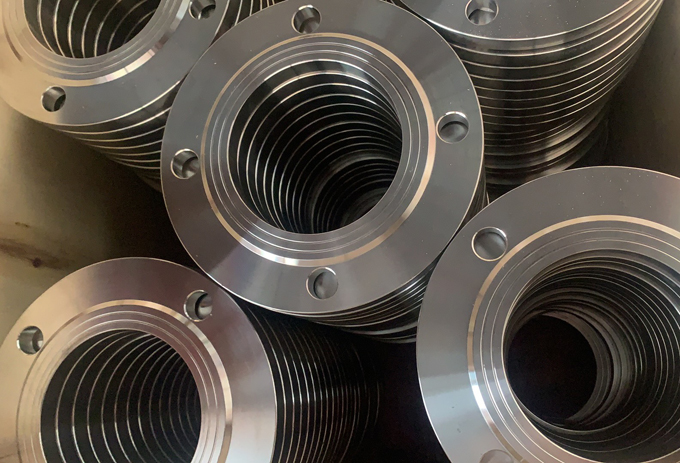In this situation, any flange will do the trick. When designing the component, it is essential to decide whether the integral flange or the loose flange should be used. This decision should be made with reference to the degree of integrity possessed by the flange ring and the straight cylinder section. The flat welding flange, in contrast to the neck butt welding flange, features a construction that is more straightforward and a design that is more straightforward. On the other hand, the rigidity and sealing performance of the flat welding flange are not even close to being as good as those of the neck butt welding flange.
As a consequence of the reduction in the diameter of the seal, the size of the compact flange has also shrunk, which has the effect of reducing the cross-section of the sealing face. Secondly, a sealing ring has been installed in place of the flange gasket so that the sealing surface can be machined. This was done so that the surface of the seal could be machined. In addition to cutting down on the amount of space and weight needed for the joint, a welding flange that is flat not only ensures that the joint will not leak and will have excellent sealing performance, but it also reduces the amount of space that is required for the joint.
As a consequence of this, the diameter of the bolts will need to be increased before they can be used. Because larger nuts need to be mated with larger bolts, nuts with larger diameters need to be used with bolts that have a larger diameter. As a result of this, it is not Flange possible to screw the nuts in any further.

Polishing techniques such as hand-polishing, mechanical polishing, chemical polishing, and electrochemical polishing can all be used on dual-phase steel flanges. As a result of the polishing and cleaning process, some chromium and phosphorus will be discharged into the waste water. Because of the microscopically inconsistent surface of the dual-phase steel flange, the microconvex part on the surface dissolves preferentially, and the rate of dissolution will be higher than that of the concave part. The entire device will require enormous size and weight, which becomes a particular problem in the offshore environment. Because of the microscopically inconsistent surface of the dual-phase steel flange, the microconvex part on the surface dissolves preferentially, and the rate ofBecause of this, the roughness that was previously present on the surface of the duplex steel flange has been smoothed out, and as a result, the surface is now glossy and smooth. Both of these processes will occur at the same time. The microscopically inconsistent surface of the will cause both of these processes to occur simultaneously.
3. This is achieved by filling in the surface scratches and pores. It has sufficient plasticity and toughness for this forming, as well as excellent resistance to stress corrosion cracking, especially in environments rich in chloride ions. Additionally, it can be formed without fracturing due to stress. Flanges made of duplex steel have yield strengths that are more than twice as high as those made of austenitic stainless steel. This is particularly useful in circumstances where Industry Standard Flange there is a high concentration of chloride ions.
1. As a result of the corrosion effect, the gasket undergoes chemical changes, the corrosive medium penetrates into the gasket, the gasket begins to soften, loses compressive force, and causes flange leakage. 2. The corrosive medium penetrates into the gasket. This will cause the tension that is currently present between the two flanges to decrease. Additionally, it will cause the sealing surface of the sealing surface to become deviated, which will make it significantly more likely that there will be a leak.
3. When the load pressure of the gasket is higher than the pressure of the internal medium, flange leakage will occur. This can happen in a number of different situations. The lack of proper installation or maintenance is typically the cause ANSI Flanges of this issue, and the solution is not overly difficult to find. When the flange clearance is too large, it will cause external loads (such as axial loads or bending loads), which will cause the gasket to be impacted or vibrated, lose the compression force, and gradually lose the kinetic energy of the seal, which will cause the flange to leak. This will occur when the flange clearance is too large. 4. Leaking flangesDue to the pressure involved, the butt joint of two adjacent flanges is the preferred method for installing flanges. Nevertheless, the temperature of the pipeline will change during the manufacturing process of the system after it has been introduced to the medium. By ensuring that the flange clearance is as minimal as possible, this issue can be sidestepped. Due to the pressure that is present, the preferred method for installing flanges is to use the butt joint of two adjacent flanges. This will cause the pipeline to expand or deform, and as a result, the flange will be subjected to bending load or shear force, which will easily result in the gasket failing. This will result in the pipeline becoming more distorted or expanded.
6. When the pipe and the flange are concentrically aligned with one another, but the space between the two bolts is larger than the bolt hole, this is referred to as a "wrong hole. "The thermal expansion and contraction of the fluid medium, in addition to the expansion or contraction of the bolt, will cause the gasket to have a gap, which will allow the medium to leak through the pressure. This gap can also be caused by the expansion or contraction of the bolt. The term for this situation is a "wrong hole. ".


